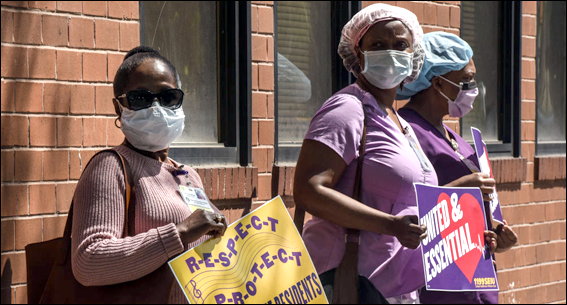This story was written by Julia Rock.

Unions have been the punching bag for the American right for decades — no matter what the societal problem, conservatives’ first scapegoat is organized labor. But if you or a relative were in a nursing home when the coronavirus pandemic hit, you would probably want to be in one whose workers were unionized — because new data suggests you’d have a better chance of surviving the disease.
The study by researchers at George Washington University and the medical schools at the University of Pennsylvania and Boston University found that nursing homes in New York state that were staffed by unionized healthcare workers saw COVID mortality rates among residents that were 30 percent lower than those in non-unionized nursing homes.
The data confirms what a body of scholarship has already shown: Patient outcomes are better when the workers taking care of them are members of unions. The findings are especially significant, because New York state nursing homes were the epicenter of the pandemic for the period of time this spring that the study authors looked at.
More than 6,600 people living in nursing homes in the state have died of COVID-19, a number that doesn’t include people who were transported from nursing homes to hospitals and died there, and therefore severely understates the COVID-19 mortality rate among nursing home residents.
Now, state officials in New York are attempting to absolve themselves of blame for the second-highest nursing home death rate in the country.
Governor Andrew Cuomo’s health department issued a report in July saying that Cuomo’s own directive to send COVID-19 infected patients from hospitals into nursing homes wasn’t a large factor in the transmission rate, instead blaming transmission on workers. But workers struggled to gain access to adequate personal protective equipment (PPE) -- a key factor in stopping transmission -- and especially those workers without unions.
This new study shows that blaming workers for transmission couldn’t be more wrong: People were less likely to die when workers had more power.
While the study concluded a strong correlation between nursing home staff unions and mortality rates, it wasn’t conducted in a manner to draw causal conclusions. But the authors put forward multiple theories about why unionized nursing homes were safer.
For one, the study found that unionized nursing homes had an 11.5 percent higher chance of having access to PPE in the early days of the outbreak than those without unionized workers.
“For six months now, people have been talking about PPE and worker safety and how to protect essential workers,” study co-author Adam Dean, a professor of political science at George Washington University who studies unions, told TMI. “But there hasn’t been that much talk about labor unions. It’s almost as if people have forgotten that one of the main things that unions do is fight for safer working conditions.”
And in the case of COVID-19, Dean said, worker safety directly translates to resident safety, because workers protecting themselves against COVID-19 means they are less likely to transmit the virus to others. “Nursing home unions demanded PPE to protect healthcare workers,” Dean said. “But better access to PPE also meant that fewer workers got sick, and that fewer nursing home residents therefore received care from infected workers.”
Study co-author Atheendar Venkataramani, a professor at the University of Pennsylvania's Perelman School of Medicine, suggested another possibility: Perhaps unionized nursing homes were able to limit transfer between residents by successfully preventing COVID-19 positive patients from being brought in to the facilities from hospitals or other facilities.
Venkataramani said that the results of the study reflect what experts already knew to be true in normal times; that when healthcare workers have better pay and more control over the conditions of their workplaces, patient outcomes are better.
Dean also pointed to a larger takeaway from the study that deserves attention, which is that unions make society safer on the whole. “The benefits of labor unions were not just for healthcare workers or even just for nursing home residents,” Dean said, “they’re for everyone. The fact that unions were associated with lower COVID-19 infection and death rates in the epicenter of the pandemic -- nursing homes in the State of New York -- really speaks to the broader societal benefits of labor unions.”
This newsletter relies on readers pitching in to support it. If you like what you just read and want to help expand this kind of journalism, consider becoming a paid subscriber by clicking this link.




